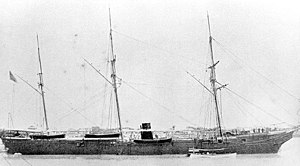USS Wachusett (1861)

| |
| History | |
|---|---|
| Name | USS Wachusett the |
| Namesake | Mount Wachusett in north central Massachusetts |
| Laid down | June 1861 at the Boston Navy Yard |
| Launched | 10 October 1861 |
| Commissioned | 3 March 1862 |
| Decommissioned | September 1885 |
| Fate | Sold 30 July 1887 |
| General characteristics | |
| Type | Sloop-of-war |
| Displacement | 1,032 tons |
| Length | 201 ft 4 in (61.37 m) |
| Beam | 33 ft 11 in (10.34 m) |
| Draft | 14 ft (4.3 m) |
| Depth of hold | 16 ft (4.9 m) |
| Propulsion | sail and steam engine backup |
| Speed | 11.5 knots (21.3 km/h; 13.2 mph) |
| Armament |
|
USS Wachusett – the first
U.S. Navy ship to be so named – was a large (1,032-ton), Mohican-class steam sloop-of-war that served the United States Navy during the American Civil War. She was outfitted as a gunboat and used by the Navy as part of the Union blockade of the Confederate States of America
.
When the war was over, Wachusett continued to serve the Navy, protecting American interests in both the Atlantic Ocean as well as the Pacific Ocean until she was finally decommissioned.
Service history
Wachusett—one of seven screw sloops-of-war authorized by the
U.S. Congress in February 1861—was laid down by the Boston Navy Yard, Boston
, Massachusetts, in June 1861; launched on 10 October; sponsored by Miss Mary C. Frothingham; and commissioned at the Boston Navy Yard on 3 March 1862, Comdr. John S. Missroon in command.
Civil War service
Wachusett's long career began on 10 March 1862 with her assignment to the
Peninsular Campaign of spring, 1862. On 4 May, a boat crew from Wachusett raised the Stars and Stripes at Gloucester Point, Virginia, following the Union occupation of Yorktown, Virginia; and, on the 6th and 7th, the vessel helped to land troops at West Point, Virginia, in the face of Confederate shore fire. Soon thereafter, the screw sloop moved to the James and, on the 15th, participated in the attack on Fort Darling, Drewry's Bluff, Virginia. She remained in the York and James rivers through August and later served with the Potomac Flotilla as Commodore Charles Wilkes' flagship
from 29 August to 7 September.

On 8 September, Wachusett was designated flagship of a special "Flying Squadron" under Commodore Wilkes. This squadron of seven vessels was deployed in the
Philadelphia Navy Yard on 19 June 1863. Repairs completed, Wachusett was recommissioned on 28 January 1864. On 4 February, she sailed for the coast of Brazil
to protect American commerce from the Confederacy's "piratical cruisers," particularly Alabama and Florida. Many months passed tracking down fruitless leads as to the whereabouts of the two vessels.
Finally, on 4 October, Comdr.
U.S. Secretary of the Navy Gideon Welles
.
Post-Civil War service

After undergoing repairs at the
New York Navy Yard
.
Recommissioned on 1 June 1871, Wachusett left New York City a week later, bound for the
South Atlantic Station where she cruised until May 1880. Following service in the Atlantic, Wachusett was transferred to the Pacific. In August 1881 Wachusett sailed to Sitka, Alaska and relieved USS Jamestown as the seat of government for the colonial Alaska District.[3] Wachusett, with Alfred Thayer Mahan in command, was stationed at Callao, Peru, protecting American interests during the final stages of the War of the Pacific.[4][5]
The vessel remained on the Pacific Station, cruising extensively until September 1885 when she was decommissioned at the Mare Island Navy Yard, Vallejo, California
. Wachusett was sold there to W. T. Garratt & Co. on 30 July 1887.
References
- ^ "SS General Sherman Incident".
- ^ "Medal of Honor Recipients – Interim Awards, 1871–1898". Medal of Honor Citations. United States Army Center of Military History. 3 August 2009. Retrieved 3 August 2010.
- ^ See https://www.naval-history.net/OW-US/Jamestown/USS_Jamestown-1879-1881.htm
- ^ See "The Ambiguous Relationship: Theodore Roosevelt and Alfred Thayer Mahan" by Richard W. Turk; Greenwood Press, 1987. 183 pgs. page 10
- ^ See Larrie D. Ferreiro 'Mahan and the "English Club" of Lima, Peru: The Genesis of The Influence of Sea Power upon History', The Journal of Military History – Volume 72, Number 3, July 2008, pp. 901–906
- This article incorporates text from the public domain Dictionary of American Naval Fighting Ships. The entry can be found here.
